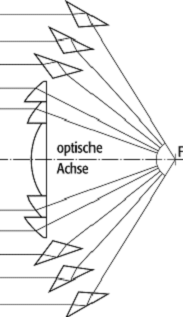
See how compact and efficient it is.
I think Fresnel and others did similar things in 19th century lighthouses, though they typically depended at least mostly on refraction. Flashlight designers should study lighthouses, because the function was similar but huge effort went into designing and building them.
The problem was similar. The emitters were Argand lamps, burning whale or lard oil and with as many as five concentric wicks. So the sources were extended, like leds are. I may have seen refracting Fresnel lens flashlights, but not recently.
If a TIR looses 15%, it is in the back of the reflector where the reflection isn’t total (if you don’t call the spill as lost). That can be mostly fixed by silvering that part. Maybe that looses the smooth edge you like, not sure. An aspheric that is coated would lose very little light that hit the lens, but the spill isn’t well controlled.
The picture you posted is a combination of TIR and Frensnel. Common Fresnel lenses don’t use the principe of total reflection at the outside (backside) of the lens, but are like collimator lenses using refraction relieved of negligible lens weight. TIRs are reflectors using smart the threshold of the angle of total reflection to ensure reasonable reflector dimensions. You can chrome-plate a Tir at the outer surface and get the same beam-characteristics, but you catch some stray photons who were out of the pattern.
Fresnel compared to “normal Lens”:

combination of Tir and fresnel:


Yes, you found an example. I think Fresnel himself (You don’t pronounce the s.) made some with TIR, so it is optional whether to call that thing a Fresnel lens or not.
You can silver the surface to make it work in an extended angular range, but metallic reflection always involves some loss.
The spots have soft edges because the outer rings are segments of longer focal length lenses or mirrors than the inner ones.